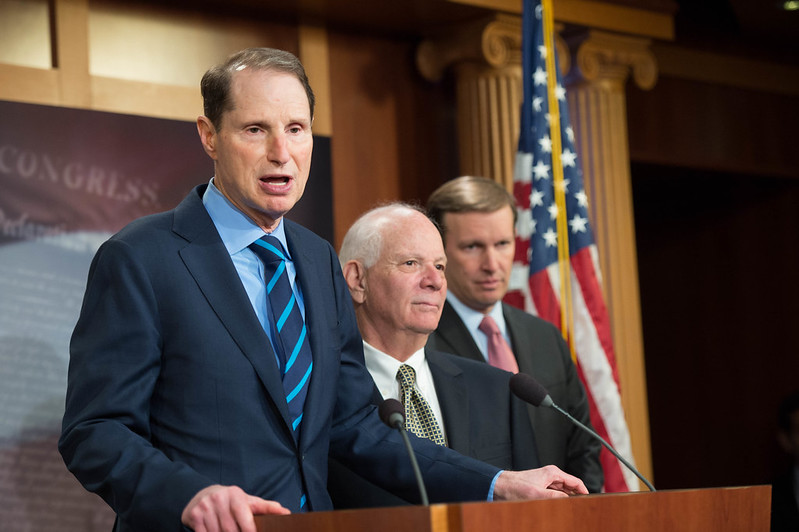
Senate Finance Committee Chairman Ron Wyden (D-Ore.) has released a set of drug pricing principles that will likely be folded into the Democrat’s upcoming multi-trillion tax and spend reconciliation legislation. Wyden’s plan includes a number of concerning proposals including the imposition of price controls on Medicare Part D under the guise of “negotiation.”
Inserting government price setting into Medicare Part D has long been a priority of the progressive left as part of their push for federal control over the American healthcare system.
The fact is, Part D already promotes competition that keeps costs low. Government price setting would do nothing to reduce costs.
Instead, Wyden’s proposal would insert federal bureaucrats into the healthcare system and would harm medical innovation and access to care. It could also threaten high-paying manufacturing jobs across the country at a time that we should be pushing policies that create more of these jobs.
Medicare Part D already has competition and negotiation
Wyden’s call to insert negotiation into Medicare Part D is misleading because there already is competition and negotiation in the healthcare program. Part D facilitates negotiation between pharmacy benefit managers (PBMs), pharmaceutical manufacturers, and plans. This system works because Congress created a non-interference clause when Part D was created which prevents the secretary of Health and Human Services (HHS) from interfering with the robust private-sector negotiations.
Since the law’s enactment, the program has proven to be a successful model of healthcare by saving taxpayers billions of dollars and granting patients access to medicines at low costs. Under this system, plans are free to compete based on the goal of maximizing access and minimizing coverage costs.
Federal spending on Part D has come in 45 percent below projections and is just 14 percent of total Medicare spending. Average monthly premiums in 2019 were just $32.50 and have been stable since 2011. Part D spending also helps keep costs in the rest of Medicare down – it has decreased hospital admissions by 8 percent, resulting in $2.3 billion in annual savings.
According to a 2020 survey, 84 percent of seniors found their Part D premiums affordable and 93 percent found their plan convenient to use. 9 in 10 seniors are satisfied with the Part D drug coverage.
Government “negotiation” would do nothing to lower costs
While Wyden says this proposal is about reducing costs, experts have repeatedly found that negotiation and the imposition of price controls would have little or no effect on reducing costs. A 2007 letter by the Congressional Budget Office noted that there would be very little savings from having the government insert itself in negotiations between private sector stakeholders.
This finding was reaffirmed in a 2019 letter by CBO Director Keith Hall who noted that “providing broad negotiating authority by itself would likely have a negligible effect on federal spending.” In addition, actuaries at the Centers for Medicare and Medicaid Services have also concluded that government negotiations would not produce any savings.
Government “negotiation” would put Washington bureaucrats in charge of Part D
Rather than promoting competition and allowing prices to be set by the free market, Wyden’s plan would allow federal bureaucrats to set prices on arbitrary basis.
This would have several adverse consequences.
First, it would harm the incentive for manufacturers to innovate because there are fewer profits available to finance the next generation of lifesaving and life-improving prescription medicines. In turn, this will result in higher long-term healthcare costs because illnesses need to be treated in a reactive, not proactive way.
Second, restricting innovation will also harm access. The U.S. is currently a world leader in medical innovation and access because it promotes free market competition. As a result, the majority of cures are developed in the United States and are launched years before other developed nations have access to them.
According to research by the Galen Institute, 290 new medical substances were launched worldwide between 2011 and 2018. The U.S. had access to 90 percent of these cures, a rate far greater than comparable foreign countries. By comparison, the United Kingdom had access to 60 percent of medicines, Japan had 50 percent, and Canada had just 44 percent.
Government “negotiation” could threaten high-paying manufacturing jobs
In addition to harming the healthcare system, a sweeping federal plan to impose government price controls on medicines could also have economic damage.
Nationwide, the pharmaceutical industry directly or indirectly accounts for over four million jobs across the U.S and in every state, according to research by TEconomy Partners, LLC. This includes 800,000 direct jobs, 1.4 million indirect jobs, and 1.8 million induced jobs, which include retail and service jobs that are supported by spending from pharmaceutical workers and suppliers.
The average annual wage of a pharmaceutical worker in 2017 was $126,587, which is more than double the average private sector wage of $60,000.
President Biden has repeatedly promised to create millions of new high paying manufacturing jobs in America. However, proposals being considered by Democrats like Sen. Wyden would threaten existing jobs.

